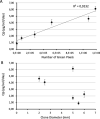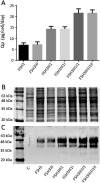Fluorescence-assisted sequential insertion of transgenes (FASIT): an approach for increasing specific productivity in mammalian cells
- PMID: 32732973
- PMCID: PMC7392891
- DOI: 10.1038/s41598-020-69709-1
Fluorescence-assisted sequential insertion of transgenes (FASIT): an approach for increasing specific productivity in mammalian cells
Abstract
Currently, the generation of cell lines for the production of recombinant proteins has the limitation of unstable gene expression due to the repeat-induced gene silencing or the loss of transgene copies resulting from recombination events. In this work, we developed a new strategy based on the sequential insertion of transgenes for generating stable clones producing high levels of a chimeric human follicle-stimulating hormone (hscFSH). Gene insertion was done by transducing HEK-293 cells with a lentiviral vector containing a bicistronic transcriptional unit for expressing hscFSH and GFP genes. Clone selection was performed by flow cytometry coupled to cell sorting, and the GFP gene was further removed by CRE-mediated site-specific recombination. High-producing clones of hscFSH were obtained after three rounds of lentiviral transduction. Expression levels increased in a step-wise manner from 7 to 23 pg/cell/day, with a relatively constant rate of 7 pg/cell/day in each round of transduction. The GFP gene was successfully removed from the cell genome without disturbing the hscFSH gene expression. Clones generated using this approach showed stable expression levels for more than two years. This is the first report describing the sequential insertion of transgenes as an alternative for increasing the expression levels of transformed cell lines. The methodology described here could notably impact on biotechnological industry by improving the capacity of mammalian cells to produce biopharmaceuticals.
Conflict of interest statement
The authors declare no competing interests.
Figures







Similar articles
-
Lentiviral Vectors Mediate Long-Term and High Efficiency Transgene Expression in HEK 293T cells.Int J Med Sci. 2015 May 15;12(5):407-15. doi: 10.7150/ijms.11270. eCollection 2015. Int J Med Sci. 2015. PMID: 26005375 Free PMC article.
-
Transient Expression of Green Fluorescent Protein in Integrase-Defective Lentiviral Vector-Transduced 293T Cell Line.Methods Mol Biol. 2016;1448:159-73. doi: 10.1007/978-1-4939-3753-0_12. Methods Mol Biol. 2016. PMID: 27317180
-
Problems encountered in bicistronic IRES-GFP expression vectors employed in functional analyses of GC-induced genes.Mol Biol Rep. 2012 Dec;39(12):10227-34. doi: 10.1007/s11033-012-1898-z. Epub 2012 Oct 18. Mol Biol Rep. 2012. PMID: 23076521
-
pLR: a lentiviral backbone series to stable transduction of bicistronic genes and exchange of promoters.Plasmid. 2012 Nov;68(3):179-85. doi: 10.1016/j.plasmid.2012.06.001. Epub 2012 Jun 20. Plasmid. 2012. PMID: 22728068
-
NUCEL (Cell and Molecular Therapy Center): a multidisciplinary center for translational research in Brazil.Mol Biotechnol. 2008 Jun;39(2):89-95. doi: 10.1007/s12033-008-9052-9. Mol Biotechnol. 2008. PMID: 18327551 Review.
Cited by
-
Repeated cell sorting ensures the homogeneity of ocular cell populations expressing a transgenic protein.PLoS One. 2022 Mar 25;17(3):e0265183. doi: 10.1371/journal.pone.0265183. eCollection 2022. PLoS One. 2022. PMID: 35333876 Free PMC article.
References
Publication types
MeSH terms
Substances
LinkOut - more resources
Full Text Sources
Miscellaneous

